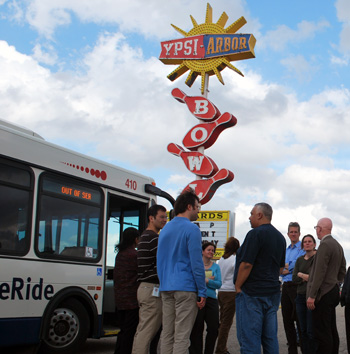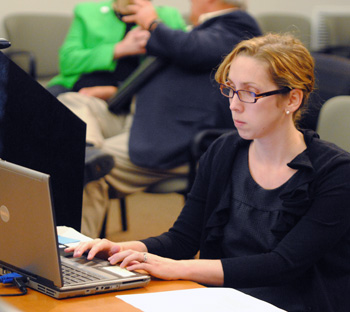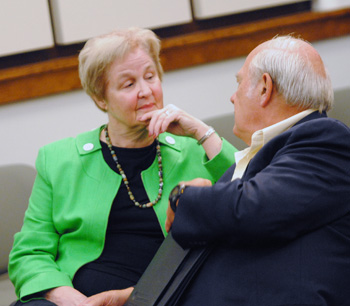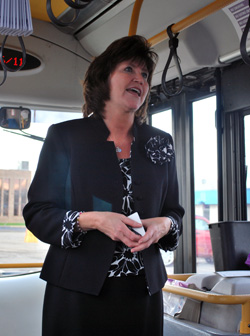County Board Briefed on Washtenaw Corridor
Transportation issues, regional cooperation and economic development were the focus of two presentations at a working session for the Washtenaw County board of commissioners earlier this month.

Ann Arbor planning commissioners and staff on a late April bus tour along Washtenaw Avenue, focusing on a project to improve that corridor between Ypsilanti and Ann Arbor. The iconic Ypsi-Arbor Bowl sign has since been removed. (Photos by the writer.)
The board got an update on the Washtenaw Avenue corridor improvement project, an effort to revitalize the county’s most congested – and, in many sections, blighted – commercial stretch. The project is focused on the roughly five miles between Ann Arbor and Ypsilanti, which also crosses land within Pittsfield and Ypsilanti townships. All four communities are involved in the project and several government leaders from those jurisdictions attended the working session, including Ypsilanti city councilmember Pete Murdock, Ann Arbor councilmember Tony Derezinski, Ypsilanti Township supervisor Brenda Stumbo and clerk Karen Lovejoy Roe, Ypsilanti Township planning commissioner Larry Krieg, and Craig Lyon, director of Pittsfield Township utilities and municipal services.
Anya Dale, the Washtenaw County planner who’s been coordinating the project, briefed commissioners on both the history and the current status of efforts along the corridor. One of the main questions – how the four communities will formally partner on the project – remains undecided. One option would be to form a corridor improvement authority (CIA), a tax increment finance (TIF) district that would provide revenues to fund improvements. Though governing boards and councils for each jurisdiction have passed resolutions of intent to form a CIA, Dale said they’re waiting on possible state legislative changes that would allow for one CIA to be formed along the entire corridor.
Another uncertainty relates to staff: Commissioners learned that Dale is leaving the county to take a job at the University of Michigan’s Office of Campus Sustainability. She’s been spending about a third of her time on the Washtenaw Avenue project, and it’s unclear who will pick up that work.
The same meeting also included an update from Michael Ford, CEO of the Ann Arbor Transportation Authority, on a possible countywide transit system. That presentation will be included in an upcoming Chronicle report.
Washtenaw Corridor Improvement Project: Overview
Anya Dale’s presentation covered familiar ground for anyone who’s attended other public forums on this project. [See Chronicle coverage: "What Does Washtenaw Corridor Need?"]
She began by describing the project’s genesis three years ago as an outgrowth of the planning effort called Ann Arbor Region Success, which involved about 70 community leaders. [The group was formed in response to news that Pfizer was pulling out of Ann Arbor and closing its large drug research complex here.]
Out of that effort, recommendations were made to focus on six major areas: (1) business acceleration and attraction; (2) secondary school options; (3) regional transit; (4) workforce housing; (5) workforce/talent development; and (6) revitalizing the eastern side of the county.
One major deficit identified was a lack of affordable housing options that are connected to vibrant parts of the county via high quality public transit. It’s especially difficult for young people who are starting their careers – they can’t find affordable housing that’s close to where they work and to the services and amenities they need, or that provides high quality public transit options.
With these things in mind, Dale said, the four communities along Washtenaw Avenue decided to focus on redeveloping that corridor. The goal is to use “smart growth” principles to enhance the quality of place for current residents, encourage efficient transportation, and accommodate the needs of the creative economy – which generally includes professions like architecture, graphic design, software development, film and music, among other fields.
In addition to the local governments of Ann Arbor, Ypsilanti, Pittsfield Township and Ypsilanti Township, the project involves other public and private sector partners too, Dale said, including the Michigan Dept. of Transportation (MDOT), the Ann Arbor Transportation Authority (AATA), the University of Michigan, and the real estate developer and property manager McKinley, among others.
Dale said public outreach has engaged many others, and has included multiple community forums, presentations to local government boards and councils, landowner and business meetings, and an online survey.

Washtenaw County planner Anya Dale, prepping for a presentation to the county board of commissioners on the Washtenaw Avenue corridor improvement project. At the June 2 working session, commissioners learned that Dale is leaving the county to take a job with the University of Michigan.
Dale described several challenges found along the five-mile stretch. In many places, there are no sidewalks for pedestrians, and no safe way for people to get to bus stops or to cross the busy five-lane road. It’s the most congested corridor in the county, with high crash rates – both car-to-car, and car-to-pedestrian. Vacancy rates in buildings along Washtenaw Avenue are also high, Dale noted.
There are also opportunities, she said. It’s located close to major employment centers, residential neighborhoods, retail and service businesses, and provides access to a major highway: US-23, with a nearby connection to I-94. There’s already high public transit use along the corridor, and ample land for redevelopment – more than 100 acres that’s either vacant or severely under-utilized, Dale said, including some that’s eligible for brownfield redevelopment.
So the four communities along the corridor realized they had common goals, she said. Among them:
- Creating a mixed use corridor, with housing, retail and office space all accessible via high-quality transit.
- Connecting vibrant neighborhoods to commercial areas via pleasant, safe walking and biking options.
- Modernizing plans and regulations to encourage infill and development.
- Removing barriers and creating incentives for development.
- Increasing the local tax base.
- Coordinating efforts to fund improvements for pedestrian, bike and vehicle uses, and enhanced transit service.
The vision is to attract people to the corridor – these goals aim to enhance the quality of life for residents and workers, Dale said. It includes providing more choices for transit, and making housing more affordable. One way to increase affordability is through improved public transit, she said – it’s not cheaper to live somewhere if you’re forced to use a car.
The corridor project also aims to reduce sprawl and pollution, Dale said, cut infrastructure costs and increase property values. From an economic development perspective, it could enhance the county’s competitiveness to attract businesses and workers, provide investment stability, and connect low- and moderate-income people to jobs through improved transit access.
The corridor hasn’t realized its potential for business investment, and it’s currently dragging down the taxable values for some of the communities there, Dale said.
Partners in the project spent much of 2009 doing public outreach and developing a vision, Dale said. In 2010, they developed recommendations for land use, transportation, and governance models, such as a corridor improvement authority (CIA). She pointed commissioners to the Reimagine Washtenaw website for more details on these recommendations.
Some University of Michigan graduate students did a redevelopment feasibility study of the corridor – their market analysis found that there’s demand for compact, mixed-use development near transit, Dale said, and that Washtenaw Avenue is an appropriate location for workforce housing.
Dale outlined several transportation improvements suggested for Washtenaw Avenue. For public transit, those include extended service hours, faster and more frequent service, Park-and-Ride options, and improved infrastructure including bus stops and pull-offs, signs and sidewalks. Improvements for bicyclists and pedestrians include pedestrian refuge islands, intersection improvements, and connections to existing bicycle pathways. And traffic congestion could be addressed by improving access to sites, reducing curb-cuts and coordinating traffic signals.
Several improvements are already underway, Dale said. They include:
- Pedestrian improvements at the US-23 interchange – part of a broader MDOT project there that will likely start construction next year.
- Sidewalks built in the Pittsfield Township section.
- Construction of a multi-use path up to Tuomy Road in Ann Arbor.
- New developments proposed at Golfside in Ypsilanti Township, and at Platt in Ann Arbor.
- A conversion from four to three lanes on Golfside Road from Packard to Clark, with bike lanes and sidewalks.
- Improvements at the Oakwood intersection.
- AATA transit improvements to Route #4.
- Improved Night Ride service.
- A Glencoe Crossings park-and-ride lot.
Washtenaw Corridor Improvement: Governance
Dale described steps that have been taken regarding the governance piece of the project, much of it related to a corridor improvement authority (CIA). She noted that the four communities have all passed resolutions of intent to form a CIA, but they’ll continue to look at whether a CIA is the best approach.

A pedestrian crossing heavy traffic on Washtenaw Avenue, south of Arborland. She eventually made it safely to the opposite side, where an AATA bus stop is located.
A CIA is a financing mechanism that would provide a way for the four communities to fund improvements to the corridor. CIAs would allow for tax-increment financing, similar to a downtown development authorities but specifically designed for commercial corridors. A tax-increment finance (TIF) district is a mechanism for “capturing” certain property taxes to be used in a specific geographic district – taxes that would otherwise be used by the entity with the authority to levy the taxes.
The benefits to a CIA are that it creates a formal partnership that allows the entity to pursue more funding options, Dale said. In addition to TIF revenues, those funding options could include federal grants, donations, special assessments, and the ability to issue bonds. Working via a CIA would bring regional consistency to development standards. It would also coordinate public investment, as well as marketing, promotion and incentives that might be offered, Dale said.
Like a downtown development authority, the CIA would be governed by a board with representatives from each community, as well as local property owners, residents, and business owners.
There are 16 CIAs in Michigan, Dale said. The Washtenaw Avenue group is using the CIA formed by Lansing, East Lansing and Lansing Township as a model, because of the multiple jurisdictions involved.
If the four communities decide to pursue a CIA, Dale said, they’d need to act within 60 days of the last public hearing focused on it. A public hearing was held earlier this year, but more than 60 days ago – and no action was taken. That means another public hearing would need to be held, if the CIA approach is pursued.
If tax increment financing is sought for this corridor, they’d need to draft a TIF plan and have it approved by the governing bodies for each of the four communities.
They’d also need to hold public hearings on the TIF plan. Taxing entities would have 60 days from those public hearings to decide whether to opt out of their revenue being captured for the district.
Aside from the decision about a CIA and TIF, next steps in 2011 and 2012 include: (1) incorporating a corridor strategy into the master plans for each jurisdiction; (2) updating zoning, parking and design standards in each jurisdiction; (3) selecting a method for an expedited permitting/review process for developments; (4) developing a project list; and (5) making a joint application for a transportation enhancement grant.
Washtenaw Corridor Improvement: Commissioner Discussion
Commissioners asked a range of questions about the project, and generally seemed supportive of it.
Barbara Bergman asked Dale how much the county was paying to support the project – what’s the funding source? It’s mostly a contribution of staff time, Dale said, adding that about a third of her time is spent on the corridor. They’ve also received small grants, she said, which were either spent internally or paid for contract work.
In response to a query from Bergman about what kind of additional support is needed, Dale said it would be good for the county to continue to provide staff time. It’s helpful to have an outside entity like the county involved in moving the conversation forward, she said, as well as to make grant applications. The project has great momentum, which Dale hoped would continue.
Leah Gunn asked about the tax increment finance (TIF) district that’s one possible funding option. Would it capture taxes from only the four jurisdictions involved in the project? Or would the TIF capture include other taxing units, like the county, the Ann Arbor District Library and Washtenaw Community College?

Washtenaw County commissioner Leah Gunn, whose district covers part of Ann Arbor, talks with Ann Arbor city councilmember Tony Derezinski at the county board's June 2 working session.
Dale said it would be possible for taxing entities like the county to opt out. The percent of tax increment capture could also be negotiated, she said – it wouldn’t have to be 100%.
Yousef Rabhi noted that when the county board had held a working session on intergovernmental cooperation earlier this year, the turnout hadn’t been great. By comparison, the turnout for this corridor working session is huge, he said, and that’s a testament to how concrete the project is, and the value that multiple communities see in it.
Noting that the board had been discussing the issue of brownfields recently, Dan Smith asked Dale to identify the location of brownfields along the corridor. Dale didn’t have an exact number, but said that many of the sites have underground storage tanks at gas stations. In addition, there are many buildings along the corridor that have been vacant for more than five years, and are functionally obsolete.
D. Smith said the brownfield component would be one obvious place where the county might be involved in the corridor project – brownfield plans submitted through the county’s brownfield redevelopment program require board approval. Would the county be asked to join a corridor improvement authority?
Dale said she thought that anyone could join a CIA, but so far, the 16 authorities in Michigan all have fewer than four members. They’re working on state legislation to broaden the language in Public Act 280 so that there could be greater representation in the CIA, she said.
County commissioners understand the complexities of tax increment financing, D. Smith said. TIF districts have benefits, but also short-term downsides. They divert tax revenues at a time when revenues are declining anyway – the county is facing a $17.5 million two-year deficit in 2012-2013, he noted. “It’s a difficult trade-off to make sometimes,” he said, and one they should be aware of.
Ronnie Peterson observed that this is one of the few times he can remember when people from Ypsilanti and Ypsilanti Township “came in peace.” That reflects their commitment to work together on this project, he said, and he hoped they would come back again.
Peterson asked Dale whether they would have to wait until legislation was passed in Lansing. Dale replied that the CIA was only one of the tools they’re considering. It would be possible right now for each of the four jurisdictions to form their own CIA, she said, but they’d rather form just one – and that requires changing the CIA enabling legislation. State legislators aren’t likely to act on it until the fall at the earliest, however. Until then, there’s work on master plans and grants that can be done, Dale said.
Peterson said he’d hate for Dale’s departure to cause the project to lose momentum. Tony VanDerworp – director of the economic development & energy department, and Dale’s boss – told commissioners that they’re still working out details of staff assignments as part of a proposed merger of three county departments: economic development & energy, the office of community development, and the employment training and community services (ETCS) department. [For background on this reorganization, see Chronicle coverage: "Three County Departments to Merge"]
The county has applied for a grant that would cover administrative costs to manage the corridor project, VanDerworp said. If they don’t get the grant, they’d likely need to talk to partners in the four Washtenaw Avenue jurisdictions to find other ways to move the project forward.

Brenda Stumbo, Ypsilanti Township supervisor, spoke to Ann Arbor planning commissioners on a bus tour of Washtenaw Avenue in late April.
Peterson complained about how the reorganization and merging of departments would bury economic development efforts within a human services department – he’s not in favor of that approach, given that the county invests significantly in economic development. He felt like the government leaders who attended that night’s working session were looking for the county to make a clear commitment – they weren’t there for just a pat on the back, he said. He asked Rabhi, who chairs the working sessions, to schedule one on the status of state legislation affecting this project, and to make sure the board gets updates on work in the corridor as it progresses. ”I don’t want us to be the dragging link to this chain,” Peterson said.
Wes Prater asked about the project’s timeline. Dale said there are several things in the works. Most communities are updating their master plans to include language related to the corridor improvement – Pittsfield Township is the farthest along in that. There are monthly meetings with a large group that includes elected officials, as well as monthly meetings of just the planners from each jurisdiction. [.pdf of tentative timeline through 2012]
If the grant doesn’t get approved, Prater wondered if the communities involved in this project would be asked for funding. Dale said the project would likely move along at a slower pace, as funding allowed. Having a staff person who could coordinate efforts of the four communities, as well as with the Michigan Dept. of Transportation and the Ann Arbor Transportation Authority, would move things along more quickly, she said.
Washtenaw Corridor Improvement: Local Communities Weigh In
Several people from other municipalities who attended the working session spoke to commissioners about the project.
Tony Derezinski, an Ann Arbor city councilmember who also serves on the city’s planning commission, reported that the city council had passed a resolution of intent to work with Pittsfield Township, Ypsilanti Township and the city of Ypsilanti to explore establishing a corridor improvement authority (CIA) along Washtenaw Avenue. [The council acted on this resolution at its Dec. 20, 2010 meeting.]
Derezinski pointed out that the city’s planning commission has put a priority on transportation corridors. Included in the planning staff’s work plan is a focus first on Washtenaw Avenue, then South State Street, Plymouth Road and North Main.
At the planning commission’s retreat in late April, the group combined its interest in corridors with an emphasis on regional planning, Derezinski said, which they see as crucial to the area’s future. That resulted in the group doing a “corridor crawl” on an AATA bus along Washtenaw Avenue, with stops along the way in each of the jurisdictions: Ann Arbor, Pittsfield Township, Ypsilanti Township, and the city of Ypsilanti. [The Chronicle attended the five-hour retreat, and rode along with planning commissioners and staff during the bus tour.]

Ann Arbor city planner Matt Kowalski, right, shakes hands with Al Berriz, CEO of McKinley, during a stop at Glencoe Hills as part of the planning commission's April 26 retreat. In the foreground is Mandy Grewal, Pittsfield Township supervisor. Glencoe Hills is an apartment complex owned by McKinley that's along a stretch of Washtenaw Avenue in Pittsfield Township.
At many of those stops, the planning commissioners talked with staff, elected officials and others who have a vested interest in that stretch of Washtenaw Avenue. One of the longer stops was at Glencoe Hills, a McKinley-owned apartment complex east of Carpenter Road in Pittsfield Township. There, the group heard from McKinley CEO Al Berriz and Mandy Grewal, Pittsfield Township supervisor, who each spoke about the importance of the corridor project.
The retreat also included a stop across from Arborland, and at the intersection of Golfside and Washtenaw, where planning commissioners talked with Ypsilanti Township supervisor Brenda Stumbo and Pittsfield Township planner Paul Montagno. [Ann Arbor planner Jeff Kahan told the group that this intersection "is where the communities kiss."] The final stop was at the western edge of Ypsilanti, at Mansfield and Washtenaw, and included a discussion with Ypsilanti city planner Theresa Gillotti.
At the June 2 county board working session, Derezinski told county commissioners there’s an exciting air of collaboration regarding the Washtenaw Avenue project – it’s the first major project where regionalism has a chance to succeed, he said.
Stumbo also spoke briefly to commissioners, calling the corridor project a great opportunity for economic development and a chance to break down some of the barriers between the east and west sides of the county. [Carpenter Road is itself a major commercial corridor running north/south and intersecting with Washtenaw Avenue near the US-23 interchange. It is considered by many to be a de facto dividing line between Ypsilanti and Ann Arbor.]
She noted that some people are leery of TIF (tax increment finance) districts, but the township is looking at it as an opportunity to stabilize its tax base through economic development. She said her understanding is that while a 50% tax capture is typical, other amounts are possible. Stumbo noted that Ypsilanti Township’s board had passed a resolution of intent regarding the corridor. If there’s a positive side to the economic downturn, she said, it’s that barriers are coming down and people are starting to work together.
Also addressing the board was Larry Krieg, a member of the Ypsilanti Township planning commission and author of the blog Wake Up, Washtenaw, which focuses on transportation issues. Krieg told the county board that he has two grandchildren living in the city of Ypsilanti, and he’s interested in building a community in which they can grow and prosper. What encourages him is that local communities are pulling themselves up by their bootstraps. Everyone knows that Washtenaw Avenue needs help, he said. Often times, people take one of two attitudes – either seeking outside help, such as federal grants, or saying “Why bother?” and giving up. For this project, Krieg said, he sees communities coming together and saying that they can do it themselves – they can improve the corridor, attract jobs and retain young talent. He said he hoped every county commissioner would support it.
Present: Barbara Levin Bergman, Leah Gunn, Ronnie Peterson, Wes Prater, Yousef Rabhi, Rolland Sizemore Jr., Dan Smith, Rob Turner.
Absent: Kristin Judge, Alicia Ping, Conan Smith
Purely a plug: The Chronicle relies in part on regular voluntary subscriptions to support our coverage of public bodies like the Washtenaw County board of commissioners. If you’re already supporting The Chronicle, please encourage your friends, neighbors and coworkers to do the same. Click this link for details: Subscribe to The Chronicle.



